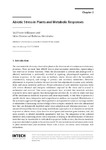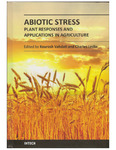
Please use this identifier to cite or link to this item:
http://ricaxcan.uaz.edu.mx/jspui/handle/20.500.11845/621Full metadata record
| DC Field | Value | Language |
|---|---|---|
| dc.contributor | 120833 | es_ES |
| dc.contributor.other | https://orcid.org/0000-0003-2949-1678 | - |
| dc.coverage.spatial | global | es_ES |
| dc.creator | Fraire Velázquez, Saúl | - |
| dc.creator | Balderas Hernández, Victor Emmanuel | - |
| dc.date.accessioned | 2018-08-08T19:21:49Z | - |
| dc.date.available | 2018-08-08T19:21:49Z | - |
| dc.date.issued | 2013-03-13 | - |
| dc.identifier | info:eu-repo/semantics/publishedVersion | es_ES |
| dc.identifier.isbn | 978-953-51-1024-8 | es_ES |
| dc.identifier.uri | http://hdl.handle.net/20.500.11845/621 | - |
| dc.identifier.uri | https://doi.org/10.48779/y917-kp56 | - |
| dc.description.abstract | The vast metabolic diversity observed in plants is the direct result of continuous evolutionary processes. There are more than 200,000 known plant secondary metabolites, representing a vast reservoir of diverse functions. When the environment is adverse and plant growth is affected, metabolism is profoundly involved in signaling, physiological regulation, and defense responses. At the same time, in feedback, abiotic stresses affect the biosynthesis, concentration, transport, and storage of primary and secondary metabolites. Metabolic adjustments in response to abiotic stressors involve fine adjustments in amino acid, carbohydrate, and amine metabolic pathways. Proper activation of early metabolic responses helps cells restore chemical and energetic imbalances imposed by the stress and is crucial to acclimation and survival. Time-series experiments have revealed that metabolic activities respond to stress more quickly than transcriptional activities do. In order to study and map all the simultaneous metabolic responses and, more importantly, to link these responses to a specific abiotic stress, integrative and comprehensive analyses are required. Metabolomics is the systematic approach through which qualitative and quantitative analysis of a large number of metabolites is increasing our knowledge of how complex metabolic networks interact and how they are dynamically modified under stress adaptation and tolerance processes. A vast amount of research has been done using metabolomic approaches to (i) characterize metabolic responses to abiotic stress, (ii) to discover novel genes and annotate gene function, and, (iii) more recently, to identify metabolic quantitative trait loci. The integration of the collected metabolic data concerning abiotic stress responses is helping in the identification of tolerance traits that may be transferable to cultivated crop species. In this review, the diverse metabolic responses identified in plants so far are discussed. We also include recent advances in the study of plant metabolomes and metabolic fluxes with a focus on abiotic stress-tolerance trait interactions. | es_ES |
| dc.language.iso | eng | es_ES |
| dc.publisher | INTECH | es_ES |
| dc.relation | https://www.intechopen.com/books/abiotic-stress-plant-responses-and-applications-in-agriculture/abiotic-stress-in-plants-and-metabolic-responses | es_ES |
| dc.relation.uri | generalPublic | es_ES |
| dc.rights | Atribución-NoComercial-CompartirIgual 3.0 Estados Unidos de América | * |
| dc.rights.uri | http://creativecommons.org/licenses/by-nc-sa/3.0/us/ | * |
| dc.source | Abiotic stress. Plant responsesand applications in agriculture, Kourosh Vahdati, Charles Leslie, editores. pp.25-48. | es_ES |
| dc.subject.classification | BIOLOGIA Y QUIMICA [2] | es_ES |
| dc.subject.other | Metabolic Responses | es_ES |
| dc.subject.other | Abiotic Stress in Plants | es_ES |
| dc.title | Abiotic Stress in Plants and Metabolic Responses | es_ES |
| dc.type | info:eu-repo/semantics/bookPart | es_ES |
| Appears in Collections: | *Documentos Académicos*-- UA Ciencias Biológicas | |
Files in This Item:
| File | Description | Size | Format | |
|---|---|---|---|---|
| InTech-Abiotic_stress_in_plants_and_metabolic_responses.pdf | 313,8 kB | Adobe PDF |  View/Open | |
| Carat Capit libro_InTech.pdf | 12,8 MB | Adobe PDF |  View/Open |
This item is licensed under a Creative Commons License
